上海版牛津英语2B教案
2B Unit1 period 1(上海版牛津英语教案)1
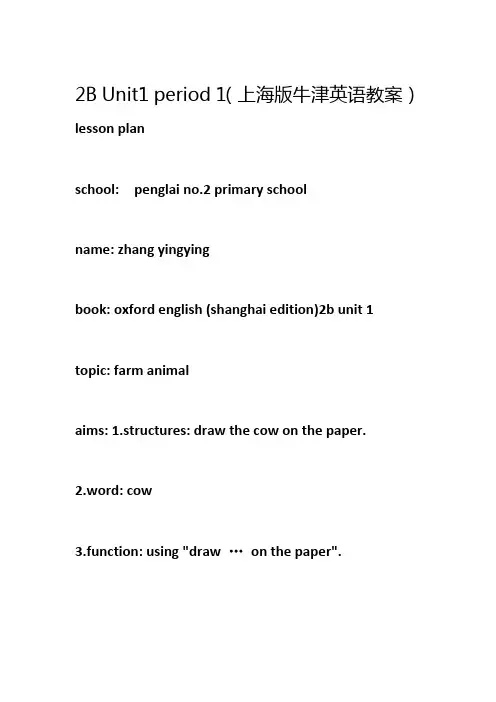
2B Unit1 period 1(上海版牛津英语教案)lesson planschool:penglai no.2 primary schoolname: zhang yingyingbook: oxford english (shanghai edition)2b unit 1topic: farm animalaims: 1.structures: draw the cow on the paper.2.word: cow3.function: using "draw …on the paper".language focus: using imperatives to give simple instructions.aids: pictures, realiaprocedurescontentsmethodspurposei. pre-task preparation1.warming-upps: sing a song about animals.1.通过歌曲,让学生对动物有初步的印象。
2.描述动物,为课文最终的综合练习打下根底。
3.协助学生区分什么是野生动物,什么是农场里动物,丰富学生的学问,进一步激发他们学习的爱好。
2.questions and answerswhich animal do you like best? why?which animal do you have as a pet?do you like …?t: ask pupils to answer the questions.pn: answer.pa: ask questions.pb: answer.3.quick responsetigers, sheep, elephants, crocodiles, ducks, cows(show the pictures)ps: farm animals.ps: wild animals.ii.while-task procedurecontent 1: cow1.introduction:t: elicit ‘cow’from the previous game.what’s this?2.imitation: cow1) t: ask pupils to follow.t-ps2) t: spell the word.pa-pb-pn通过机械性的仿说及拼读,使学生对所学单词根本驾驭。
上海版牛津小学英语2b教案全册 2B教案U5_2
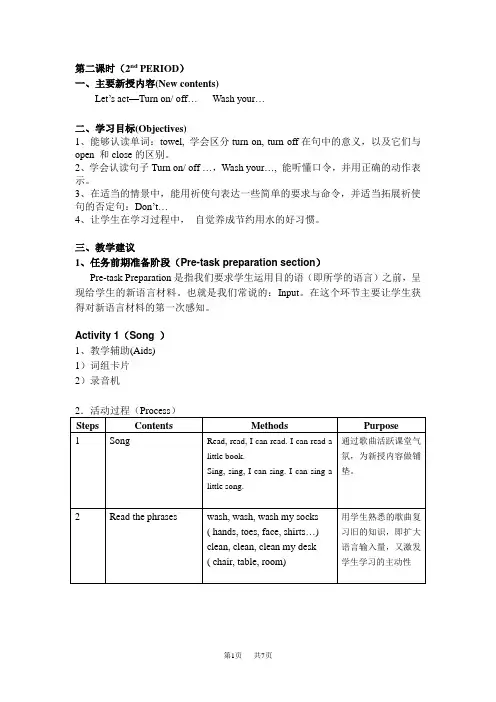
第二课时(2nd PERIOD)一、主要新授内容(New contents)Let’s act—Turn on/ off…Wash your…二、学习目标(Objectives)1、能够认读单词:towel, 学会区分turn on, turn off在句中的意义,以及它们与open 和close的区别。
2、学会认读句子Turn on/ off …,Wash your…, 能听懂口令,并用正确的动作表示。
3、在适当的情景中,能用祈使句表达一些简单的要求与命令,并适当拓展祈使句的否定句:Don’t…4、让学生在学习过程中,自觉养成节约用水的好习惯。
三、教学建议1、任务前期准备阶段(Pre-task preparation section)Pre-task Preparation是指我们要求学生运用目的语(即所学的语言)之前,呈现给学生的新语言材料。
也就是我们常说的:Input。
在这个环节主要让学生获得对新语言材料的第一次感知。
Activity 1(Song )1、教学辅助(Aids)1)词组卡片2)录音机Activity 2(Rhyme )1、教学辅助(Aids)1) 录音机Activity 3(Read a chant )1、教学辅助(Aids)1)录音机2)单词卡片2、任务中期实施阶段(While-task procedure section)While-task Procedure,这是指语言技能的习得过程。
其中分为机械性操练和意义性操练两部分。
机械性操练可以让学生准确地模仿、复说新授的语言,让他们经过从模仿到识记的过程,使新知识由感知、理解、模仿直到储存。
由于本教时新授内容有词汇也有句子而且都在两个以上,在这个教学阶段也可以设计新授知识的二次或多次导入,并根据语言训练的需要设计相应的机械性操练和意义性操练。
在这种情况下,建议每项Activity形式尽可能不同,时间不要长,一个活动紧接着一个活动,容易抓住学生的注意力,维持学习兴趣。
沪教牛津英语2b教案
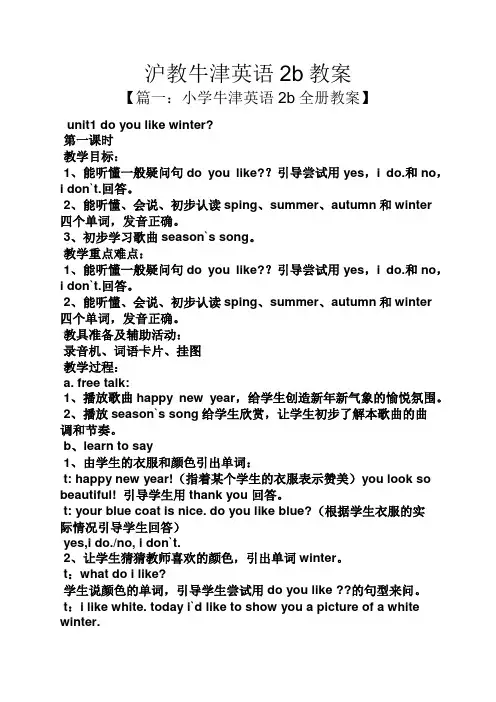
沪教牛津英语2b教案【篇一:小学牛津英语2b全册教案】unit1 do you like winter?第一课时教学目标:1、能听懂一般疑问句do you like??引导尝试用yes,i do.和no,i don`t.回答。
2、能听懂、会说、初步认读sping、summer、autumn和winter四个单词,发音正确。
3、初步学习歌曲season`s song。
教学重点难点:1、能听懂一般疑问句do you like??引导尝试用yes,i do.和no,i don`t.回答。
2、能听懂、会说、初步认读sping、summer、autumn和winter四个单词,发音正确。
教具准备及辅助活动:录音机、词语卡片、挂图教学过程:a. free talk:1、播放歌曲happy new year,给学生创造新年新气象的愉悦氛围。
2、播放season`s song给学生欣赏,让学生初步了解本歌曲的曲调和节奏。
b、learn to say1、由学生的衣服和颜色引出单词:t: happy new year!(指着某个学生的衣服表示赞美)you look so beautiful! 引导学生用thank you 回答。
t: your blue coat is nice. do you like blue?(根据学生衣服的实际情况引导学生回答)yes,i do./no, i don`t.2、让学生猜猜教师喜欢的颜色,引出单词winter。
t:what do i like?学生说颜色的单词,引导学生尝试用do you like ??的句型来问。
t:i like white. today i`d like to show you a picture of a white winter.教师出示冬天的图片,引出winter,组织学生听单词录音,朗读单词。
3、以相同的方法学习单词sping、summer、autumn。
上海版牛津英语2b教案
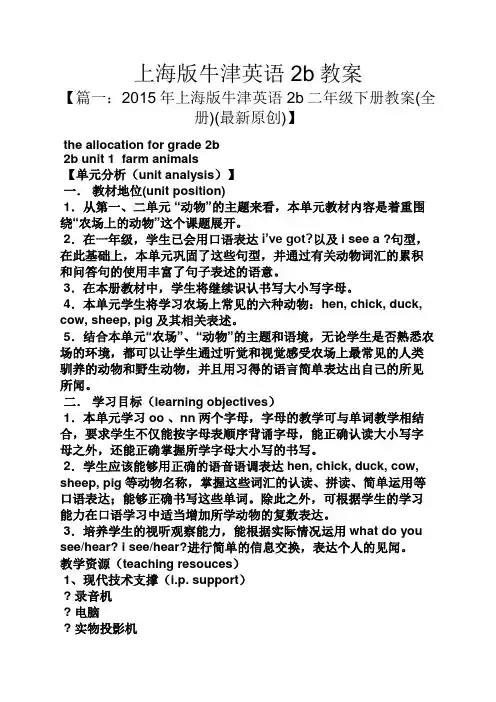
上海版牛津英语2b教案【篇一:2015年上海版牛津英语2b二年级下册教案(全册)(最新原创)】the allocation for grade 2b2b unit 1 farm animals【单元分析(unit analysis)】一.教材地位(unit position)1.从第一、二单元“动物”的主题来看,本单元教材内容是着重围绕“农场上的动物”这个课题展开。
2.在一年级,学生已会用口语表达i’ve got?以及i see a ?句型,在此基础上,本单元巩固了这些句型,并通过有关动物词汇的累积和问答句的使用丰富了句子表述的语意。
3.在本册教材中,学生将继续识认书写大小写字母。
4.本单元学生将学习农场上常见的六种动物:hen, chick, duck, cow, sheep, pig及其相关表述。
5.结合本单元“农场”、“动物”的主题和语境,无论学生是否熟悉农场的环境,都可以让学生通过听觉和视觉感受农场上最常见的人类驯养的动物和野生动物,并且用习得的语言简单表达出自己的所见所闻。
二.学习目标(learning objectives)1.本单元学习oo 、nn两个字母,字母的教学可与单词教学相结合,要求学生不仅能按字母表顺序背诵字母,能正确认读大小写字母之外,还能正确掌握所学字母大小写的书写。
2.学生应该能够用正确的语音语调表达hen, chick, duck, cow, sheep, pig等动物名称,掌握这些词汇的认读、拼读、简单运用等口语表达;能够正确书写这些单词。
除此之外,可根据学生的学习能力在口语学习中适当增加所学动物的复数表达。
3.培养学生的视听观察能力,能根据实际情况运用what do you see/hear? i see/hear?进行简单的信息交换,表达个人的见闻。
教学资源(teaching resouces)1、现代技术支撑(i.p. support)录音机电脑实物投影机多媒体软件2、视听材料辅助(audio-visual aids)图片实物3、学习材料(materials)学生用书配套练习册四.课时划分(period division)2b unit 1 farm animals【单元分析(unit analysis)】三.教材地位(unit position)1.从第一、二单元“动物”的主题来看,本单元教材内容是着重围绕“农场上的动物”这个课题展开。
上海版牛津英语2B课程教案
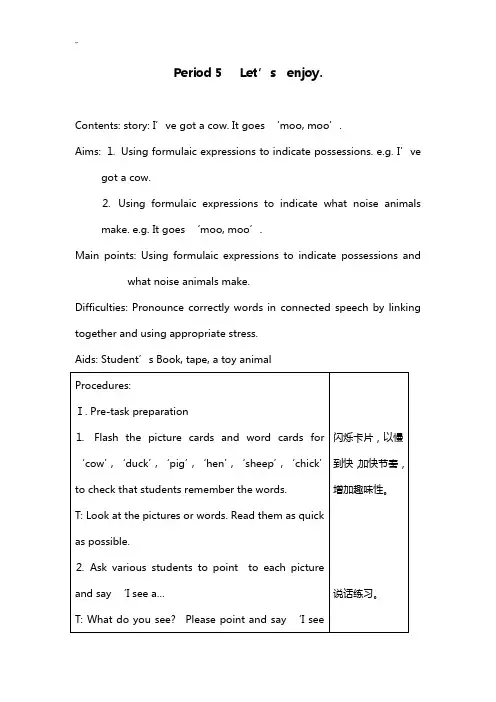
Period 5 Let’s enjoy.Contents: story: I’ve got a cow. It goes ‘moo, moo’.Aims: ⒈Using formulaic expressions to indicate possessions. e.g. I’ve got a cow.⒉Using formulaic expressions to indicate what noise animalsmake. e.g. It goes ‘moo, moo’.Main points: Using formulaic expressions to indicate possessions and what noise animals make.Difficulties: Pronounce correctly words in connected speech by linking together and using appropriate stress.Aids: Student’s Book, tape, a toy animal2B Unit 1 Farm AnimalsPeriod 1 Let’s learnContents: 1.Word: hen, chick, duck, cow, pig2.Letter: N n nose, O o orangeAim: ing nouns to identify common farm animals.e.g. hen, chick2.Learn the above names and sounds of the letters ‘N n, O o’.3.Knowning about the farm animals and say something aboutthe animals you like.Main points: Using nouns to identify common farm animals. Difficulties: Pronounce words properly.Aids: 1.T: picture cards, words cards, tape, Student’s Book and Wordbook.P: picture cards (students prepared beforehand )Period 2 Let’s talkContents: What do you see? I see┄What do you hear? I hear┄Aims: 1. Asking ‘wh’questions to find out specific information about a farm.e.g. What do you see /hear?2.Using the simple present tense. e.g. I see/hear a duck.Main Points: Asking and answering the ‘wh’questions. Difficulties: Using the models to communicate with other learners. Aids: the wallchart for page 3, six picture cards and six word cards ,tape , Student’s Book and WorkbookProcedures:ⅠPre-task preparation⒈Show six toy farm animals or pictures of them.Ask students to name in English.⒉Show sixword cards. Ask students to read them.Period 3 Let’s actContents: Draw the cow on the paper. Draw the duck on the ground. Aims: ⒈Using imperatives to give simple instructions. e.g. Draw the cow on the paper.⒉Locating specific information in response to simple instructions.⒊Using modeled phrases to communicate with other learners. Main points: Using imperatives to give simple instructions. Difficulties: Using modeled phrases to communicate with other learners. Aids: plain sheets of paper, toy animals, animal picture cards, tape, Workbook, Student’s BookPeriod 4. Let’s play.Contents: Listen, tick and say: I hear a…Aims: ⒈Using the simple present tense to indicate what you hear. e.g. I hear a sheep.2. Using nouns to refer to farm animals. e.g. cowMain points: Using the simple present tense to indicate what you hear. Difficulties: Recognizing key words of the animals.Aids: Student’s Book and Workbook, tape, word and picture cards2B Unit2 In the circus Period1 Let’s act Teaching aims:1)Locate specific information in response to simple instructions.2)Use imperatives to give simple instructions.3)Learn the sentences: Come here. Go there. Come back . Education aims:Foster the thought of loving animals.Difficult points:Using imperatives to give simple instructions.Materials:Cassette 2B and cassette player.Animal masksTeaching essay2B Unit2 In the circus Period2 Let’s learn Teaching aims:1)Learn the words: horse, bear, elephant, tiger, monkey, panda.2) Pronounce words properly.Education aims:Foster the thought of loving animals.Difficult points:Using nouns to identify animals.e. g. bear, elephantMaterials:Cassette 2B and a cassette player.Wookbook 2B page 6.Animal masks.Teaching essay2B Unit2 In the circus Period3 Let’s talk Teaching aims:1)Learn the sentences: Look at the…It’s…and…2) Use imperatives to draw attention to something.3 ) Use adjectives to describe animals.Education aims:Foster the thought of loving animals.Difficult points:Use imperatives to draw attention to the animals and describe them.Materials:Cassette 2B and a cassette playerWord and picture cards (animals)Wallchart 2BAnimalsTeaching essay2B Unit 2 Period 4 In the circus Letters Basic aim: ing nouns to identify things.. .. e.g. pencil, quilt.2. Learning the letters: Pp , Qq.Difficult point: Writing the lettersTeaching essay2B Unit 2 Period 5 Let’s play Guess Who’s my friend? Basic aim:ing connectives to link two adjectives.e.g. She is little and white.2.Asking “Wh-’’questions to find out specific information abouta person.e.g. Who is she?Developing aims:1.Learn other words. e.g. tail,short.2.Make a riddle.Materials: cassette,player,toys,masks.Teaching procedure:Teaching essayUnit 2 Let’s enjoyPeriod 6 Song Basic aim:ing imperatives to draw attention to somethinge. g. Look at the bear.ing adjectives to describe animalse. g. It’s big and brown.Developing aims:1.Rhyme2.Like animals, like nature.Materials:Cassette, player, pictures, masks.Teaching procedure:Teaching essayUNIT 3 Let’s learnPeriod 1Teaching aims:1.Basic aims: a. To learn the letters: Rr Ss.b. To learn the words: rubber, sweet.c. Add a new word: chocolate.2.Developing aims: using the words to make some sentences, make some dialogues or some rhymes.Main points: To learn the letters and the words.Difficult points: The pronunciation of ‘Rr’.Materials: letter cards, picture cards, cassette.Teaching essayUNIT 3 Let’s learnPeriod 2Teaching aims:1.Basic aims:To learn the seven words: window, door, bed, room, sofa, table, lamp.2.Developing aims: Using the words to describe a room.Main points: To learn the words.Difficult points: Using some English to describe the words. Materials: cassette, picture cards, a big picture of a room.Teaching essayUNIT 3 Let’s actPeriod 3Te aching aims:1.Basic aims: Using imperative to give simple instructions: Close the window, please.2. Developing aims: Using imperative in the correct situation. Main points and difficult points:Use modelled phrases to communicate with other learners. Materials: cassette, picture cards, the picture of ‘my room’Teaching essay2B UNIT 3 Let’s talkPeriod 4Teaching aims:1.Basic aims:(1)Using the simple present tense to indicate facts. E.g. This is myroom.(2)Using introductory ‘There’to express facts. E.g. There is / are…in my room.2. Developing aims: T o describe one place using ‘There is/are…’. Education aims: Let the students to love their homes.Main points and difficult points:Using ‘This is …’‘There is/are …’to express facts. Materials: cassette, the tape of listening( 2parts),the tape of the sounds(the admire and bewail sounds),some pictures, cards. etc.。
上海版牛津英语2b教案全册
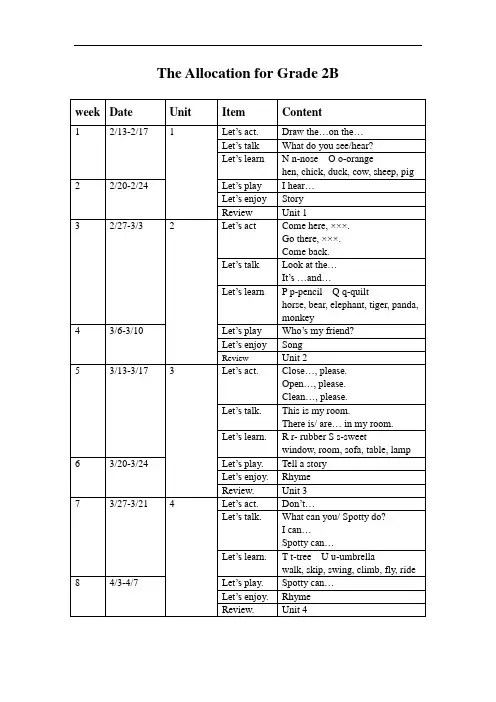
The Allocation for Grade 2B2B Unit 1 Farm animals【单元分析(UNIT ANALYSIS)】一.教材地位(UNIT POSITION)1.从第一、二单元“动物”的主题来看,本单元教材内容是着重围绕“农场上的动物”这个课题展开。
2.在一年级,学生已会用口语表达I’ve got…以及I see a …句型,在此基础上,本单元巩固了这些句型,并通过有关动物词汇的累积和问答句的使用丰富了句子表述的语意。
3.在本册教材中,学生将继续识认书写大小写字母。
4.本单元学生将学习农场上常见的六种动物:hen, chick, duck, cow, sheep, pig及其相关表述。
5.结合本单元“农场”、“动物”的主题和语境,无论学生是否熟悉农场的环境,都可以让学生通过听觉和视觉感受农场上最常见的人类驯养的动物和野生动物,并且用习得的语言简单表达出自己的所见所闻。
二.学习目标(LEARNING OBJECTIVES)1.本单元学习Oo 、Nn两个字母,字母的教学可与单词教学相结合,要求学生不仅能按字母表顺序背诵字母,能正确认读大小写字母之外,还能正确掌握所学字母大小写的书写。
2.学生应该能够用正确的语音语调表达hen, chick, duck, cow, sheep, pig等动物名称,掌握这些词汇的认读、拼读、简单运用等口语表达;能够正确书写这些单词。
除此之外,可根据学生的学习能力在口语学习中适当增加所学动物的复数表达。
3.培养学生的视听观察能力,能根据实际情况运用What do you see/hear?I see/hear…进行简单的信息交换,表达个人的见闻。
教学资源(TEACHING RESOUCES)1、现代技术支撑(I.P. support)♦录音机♦电脑♦实物投影机♦多媒体软件2、视听材料辅助(Audio-visual aids)♦图片♦实物3、学习材料(Materials)♦学生用书♦配套练习册四.课时划分(PERIOD DIVISION)2B Unit 1 Farm animals【单元分析(UNIT ANALYSIS)】三.教材地位(UNIT POSITION)1.从第一、二单元“动物”的主题来看,本单元教材内容是着重围绕“农场上的动物”这个课题展开。
上海版牛津英语2b教案全册
Unit 1 Where I LiveTeaching aids:A. Words : letters Aa --Bb , bin , park , road , building , ShanghaiB. Structures : I live in …. I love …. I see …. That’s …C. Functions : Give simple instructions; Refer to specific classroom objects.Material:1. Student's Book 2A page 2--62. Cassette 1A and a cassette player3. Wallcharts4. Photograph page 15. Alphabet CardsTeaching times:5 timesLearning targets:A. Basic aims:1. Be able to identify the letters Aa -- Bb2. Be able to give simple instructions3. Be able to use the simple present tense to indicate facts4. Be able to "point to your home"5. Read the rhymeB. Further aims:1.2.Practise saying a new rhyme substituting 'Shanghai' with another places Language focus:1. Using the definite article to refer to specific classroom objects2. Using the simple present tense to express interests and preferences3. Learning the words: bin , park , road , building , ShanghaiPeriod 1Teaching focus:Using imperatives to give simple instructionsUsing the definite article to refer to specific classroom objectsPeriod 2Teaching focus:Using the simple present tense to indicate factsUsing the simple present tense to express interests and preferencesPeriod 3Teaching focus:Using nouns to identify objectUsing proper nouns to refer to placesPeriod 4Teaching focus:Asking ' Wh-' questions to find out various kinds of specific information about a person Using the simple persent tense to express truthUsing the simple persent tense to express interests and preferencesPeriod 5Teaching focus:Using the simple persent tense to express interests and preferencesUnit 4 Going aboutTeaching designing:Teaching aids:A.Words: letters Gg—Hh, plane, ferry, train, taxi, car, bus, van.B.Structures: Get ……How do you go to……C.Functions: Give simple instructions; Using connectives to add information Material:1.Student’s Book 2A page 17-212.Cassette 1A and a cassette player3.Wall charts4.Photograph page 145.Alphabet CardsTeaching times:5 timesLearning targets:A.B asic aims:1.Be able to identify the letters Gg--Hh2.Be able to give simple instructions3.Be able to introduce oneself using I’m.4.Be able to write the sentence Hello, I’m <name>.5.Sing a song.B.Further aims:ing more information to introduce oneself2.The sorts of the alphabetLanguage focus:ing imperatives to give simple instructions2.Asking How questions to find out means and Using prepositions to indicate meas3.Learning the words: plane……Period 1Teaching focus:Using imperative to give simple instructionsTeaching steps:Period 2Teaching focus:Asking How questions to find out mean Using prepositions to indicate means Using formulaic expressions to take leave Teaching steps:Period 3Teaching focus:Using nouns to identify forms of transport. Teaching steps:Period 4Teaching focus:Using formulaic expressions to indicate how people travel Teaching steps:Period 5Teaching focus:Using nouns to identify different forms of transport Teaching steps:Unit 5 Crossing the roadTeaching designing:Teaching aids:D.Words: letters—Ii Jj, stop, light, go, fast, slow.E.Structures: Look at the light. It’s…, Go! / Stop! / Wait! /F.Functions: Using imperatives to give simple instructions; To give simpleinstructions.Material:6.Student’s Book 2A page 22-267.Cassette 1A and a cassette player8.Wall charts9.Photograph page 1410.Alphabet CardsTeaching times:5 timesLearning targets:C.Basic aims:6.Be able to identify the letters Ii--Jj7.Be able to give simple instructions8.Be able to introduce oneself using I’m.9.Be able to write the sentence Hello, I’m <name>.10.Sing a song.D.F urther aims:ing more information to introduce oneself4.The sorts of the alphabetLanguage focus:ing imperatives to give simple instructionsing adjectives to describe objects6.Learning the words: stop……Period 1Teaching focus:Using imperative to give simple instructionsTeaching steps:Period 2Teaching focus:Using imperative to give simple instructions Using adjectives to describe objectsTeaching steps:Period 3Teaching focus:Using imperatives to give simple instructions Using nouns to identify thingsUsing adjectives to describe objects Teaching steps:Period 4Teaching focus:Using imperative to give instructions Using adjectives to describe coloursTeaching steps:Period 5Teaching focus:Using imperatives to give simple instructions Using adjectives to describe objectsTeaching steps:。
上海版牛津英语2B教案 (2)
Unit 7 Hot Summer Period 1Education Aims:Don’t leave rubbish on the beach. Teaching Aims:1.Basic aims.A: To learn the words: beach, shells B: To learn the drills.e. g. Let’s go to the beach.2.Developing Aims:A: Say another sentences.e.g. Let’s pick up rubbish.B: Free talk.Materials:Cassette player, pictures, objectsUnit 7 Hot SummerPeriod 2 Let’s talk Education Aims:To be friendly each other .Teaching Aims:1.Learn the drills.e.g. Summer is hot .2.Learn the dialogue.A: I’m sorry.B: It’s OK.Materials: cassette player, pictures, objects.Teaching Procedure:Unit 7 Hot summerPeriod 3 Let’s learn Education Aims:Don’t eat much ice-cream in summer.Teaching Aims:1.Learn the words: e.g. cloud2.Learn the letter: Y yMaterials: cassette player, word and letter cards.Period 4 Let’s play Education Aims:Don’t eat too many ice-creams.Teaching Aims:A: Basic Aims.Learn to say the sentences.e.g. The sun is hot.Let’s sit under the umbrella.B: Developing Aims.Free talk about winter.Materials: cassette player, some pictures, cards Ask the pupils to make some pictures before class.Period 5 Let’s enjoyEducation Aims:To be friendly each other .Teaching Aims:A: Basic Aims:Learn to say the rhyme.B: Developing Aims:Free talk.Materials: cassette player, pictures.。
2B Unit1 period 2(上海版牛津英语教案)
2B Unit1 period 2(上海版牛津英语教案)lesson planschool: penglai no.2 primary schoolname: zhang yingyingbook: oxford english (shanghai edition)2b unit 1topic: farm animalaims: 1. structures: draw the duck on the ground.2.words: duck, chick3. function: using "draw ?on the ?.language focus: using imperatives to give simple instructions.aids: computer, radio, picturesprocedurescontentsmethodspurposei. pre-taskpreparation1. warming-upps: say a chant about animals.1. 通过同学宠爱的节奏小诗,调动同学学习的乐观性,并对多种动物进行复习。
2.让同学通过记忆来描述他们所看到的动物, 以起到巩固复习作用,同时,也能起到培育同学的观看力量的作用。
2. questions and answerswhat do you see?(computer)t: show some animals and ask students to remember what they see.pn: i see a cow. (etc.)3. quick responset: put the animals on the paper.pn: draw the ?on the paper.ii. while-task procedurecontent 1: ground1. introduction:t: put the cat on the ground. draw the cat on the ground.1. 同学通过机械的朗读及拼读,对所学单词基本把握。
上海版牛津英语2B教案
Period 5 Let’s enjoy.Contents: story: I’ve got a cow. It goes ‘moo, moo’.Aims: ⒈Using formulaic expressions to indicate possessions. e.g. I’ve got a cow.⒉Using formulaic expressions to indicate what noise animals make. e.g. Itgoes ‘moo, moo’.Main points: Using formulaic expressions to indicate possessions and what noise animals make.Difficulties: Pronounce correctly words in connected speech by linking together and using appropriate stress.2B Unit 1 Farm AnimalsPeriod 1 Let’s learnContents: 1.Word: hen, chick, duck, cow, pig2.Letter: N n nose, O o orangeAim: ing nouns to identify common farm animals.e.g. hen, chick2.Learn the above names and sounds of the letters ‘N n, O o’.3.Knowning about the farm animals and say something about the animalsyou like.Main points: Using nouns to identify common farm animals.Difficulties: Pronounce words properly.Aids: 1.T: picture cards, words cards, tape, Student’s Book and Wordbook.P: picture cards (students prepared beforehand )Period 2 Let’s talkContents: What do you see? I see┄What do you hear? I hear┄Aims: 1. Asking ‘wh’ questions to find out specific information about a farm.e.g. What do you see /hear?2.Using the simple present tense. e.g. I see/hear a duck.Main Points: Asking and answering the ‘wh’ questions.Difficulties: Using the models to communicate with other learners.Aids: the wallchart for page 3, six picture cards and six word cards ,tape , Student’s Procedures:ⅠPre-task preparation⒈Show six toy farm animals or pictures of them. Askstudents to name in English.⒉Show six word cards.Ask students to read them.⒊Match the words to the pictures on the board.⒋Ask: ①What comes from a hen?/ Where does an eggcome from?②Where does milk/a chick /a hen come from?Ⅱ. While-task procedure⒈While putting your hands on your eyes like a telescope,say ‘What do you see?’Then putting your hand on yourear like listening, say ‘What do you see?’ Getthe students to do the actions like you while repeating thequestions after you.⒉Put up the wallchart for page 3 tell a story something likethis:T: Look at the picture of a farm. This boy is Sam andthis girl is May. They’re brother and sister. This old manis their grandfather. Sam and May sometimes go to thecountry to visit their grandfather. Their grandfather is afarmer. Sam and May like to go to his farm to see theanimals. There are a lot of animals on the farm: a pig,sheep, cows, a duck and even a hen with baby chicks.How many of them do you see in the picture? S: I see…⒊Play the sounds of the animals on the recording andanswer the questions ‘What do you hear?’bysaying ‘I hear…’⒋Listen to the story again. Then answer the questionsand such as the following:①Who is the boy/girl/old man? (Sam, May, grandfather)②Wh at is Sam and May’s grandfather? (He is a farmer.)③Are there many animals on his farm? (Yes, there are.)④What animals has grandfather got on his farm? (He hasgot a pig, sheep, cows, a duck, a hen and chicks.)⑤What do you see in the picture? (I see…)⑥What do you hear on the tape? (I hear…)⒌Open their books. Listen to the let students hear thePeriod 3 Let’s actContents: Draw the cow on the paper. Draw the duck on the ground.Aims: ⒈Using imperatives to give simple instructions. e.g. Draw the cow on the paper.⒉Locating specific information in response to simple instructions.⒊Usingmodeled phrases to communicate with other learners.Main points: Using imperatives to give simple instructions.Difficulties: Using modeled phrases to communicate with other learners.Aids: plain sheets of paper, toy animals, animal picture cards, tape, Workbook,Period 4. Let’s play.Contents: Listen, tick and say: I hear a…Aims: ⒈Using the simple present tense to indicate what you hear. e.g. I hear a sheep.2. Using nouns to refer to farm animals. e.g. cowMain points: Using the simple present tense to indicate what you hear. Difficulties: Recognizing key words of the animals.Aids: Student’s Book and Workbook, tape, word and picture cards2B Unit2 In the circus Period1 Let’s act Teaching aims:1)Locate specific information in response to simple instructions.2)Use imperatives to give simple instructions.3)Learn the sentences: Come here. Go there. Come back . Education aims:Foster the thought of loving animals.Difficult points:Using imperatives to give simple instructions.Materials:Cassette 2B and cassette player.2B Unit2 In the circus Period2 Let’s learn Teaching aims:1)Learn the words: horse, bear, elephant, tiger, monkey, panda.2) Pronounce words properly.Education aims:Foster the thought of loving animals.Difficult points:Using nouns to identify animals.e. g. bear, elephantMaterials:Cassette 2B and a cassette player.Wookbook 2B page 6.Teaching essay2B Unit2 In the circus Period3 Let’s talk Teaching aims:1)Learn the sentences: Look at the…It’s… and…2) Use imperatives to draw attention to something.3 ) Use adjectives to describe animals.Education aims:Foster the thought of loving animals.Difficult points:Use imperatives to draw attention to the animals and describe them. Materials:Cassette 2B and a cassette playerWord and picture cards (animals)Wallchart 2BTeaching essay2B Unit 2 Period 4 In the circus LettersBasic aim: ing nouns to identify things.. .. e.g. pencil, quilt.2. Learning the letters: Pp , Qq.Difficult point: Writing the letters2B Unit 2 Period 5 Let’s play Guess Who’s my friend?Basic aim:ing connectives to link two adjectives.e.g. She is little and white.2.Asking “Wh-’’questions to find out specific information about a person.e.g. Who is she?Developing aims:1.Learn other words. e.g. tail,short.2.Make a riddle.Materials: cassette,player,toys,masks. Teaching procedure:Unit 2 Let’s enjoy Period 6 SongBasic aim:ing imperatives to draw attention to somethinge. g. Look at the bear.ing adjectives to describe animalse. g. It’s big and bro wn.Developing aims:1.Rhyme2.Like animals, like nature.Materials:Cassette, player, pictures, masks.UNIT 3 Let’s learnPeriod 1 Teaching aims:1.Basic aims: a. To learn the letters: Rr Ss.b. To learn the words: rubber, sweet.c. Add a new word: chocolate.2.Developing aims: using the words to make some sentences, make some dialogues or some rhymes.Main points: To learn the letters and the words.Difficult points: The pronunciation of ‘Rr’.UNIT 3 Let’s learn Period 2Teaching aims:1.Basic aims:To learn the seven words: window, door, bed, room, sofa, table, lamp.2.Developing aims: Using the words to describe a room.Main points: To learn the words.Difficult points: Using some English to describe the words. Materials: cassette, picture cards, a big picture of a room.UNIT 3 Let’s actPeriod 3Te aching aims:1.Basic aims: Using imperative to give simple instructions:Close the window, please.2. Developing aims: Using imperative in the correct situation.Main points and difficult points:Use modelled phrases to communicate with other learners.2B U NIT 3 Let’s talkPeriod 4Teaching aims:1.Basic aims:(1)Using the simple present tense to indicate facts. E.g. This is my room.(2)Using introductory ‘There’ to express facts. E.g. There is / are… in my room.2. Developing aims: To describe one place using ‘There is/are…’.Education aims: Let the students to love their homes.Main points and difficult points:Using ‘This is …’ ‘There is/are …’ to express facts.Materials: cassette, the tape of listening( 2parts),the tape of the sounds(the admire and2B UNIT 3 Let’s playPeriod 5Teaching aims:1.Basic aims: Using prepositions to indicate positions. E.g. There is a lamp onthe table.2. Developing aims: To describe the story fluently.Education aims: Let the children be interested with the story.Main points: Repeat the story.Difficult points: The using of the prepositions: on, under, in.2B UNIT 3 Let’s enjoyPeriod 6Teaching aims:1. Basic aims: To learn the story and repeat it.2. Developing aims: To say the rhyme using appropriate stress. Education aims: Let the children fell interesting with the English. Main points: To say the rhyme correctly.Difficult points: To say the rhyme using appropriate stress.2B Unit 4 In the parkThe first period Let’s learnTeaching Aims:Basic aims:Using verbs to identify momentary actions:e.g. walk, climb, skip, swing, fly, ride Difficult points: Using the verbs to say sentences Education Aims: To love sports and deep a good health Materials: Picture and word cards2B Unit 4 In the parkThe second period Let’s actTeaching Aims :Basic aims: Using imperatives to express prohibitione.g. Don’t walk on the grass.Difficult points : Using imperatives to express prohibition Education Aims : To protect the surroundingMaterials : Picture2B Uint 4 In the parkThe third periodLet’s talkTeaching Aims:Basic aims : 1. Using the modal verb “can” to express abilitiese.g. I can climb.2.Asking “Wh-“ questions to find out particular information abouta persone.g. What can you do?Difficult points : Using verbs to indicate momentary actionse.g. I can skip.Education Aims : To love sportsMaterials : PicturesUnit4 In the park LettersThe fourth period Teaching aims:1)Using nouns to identify things. e.g. tree umbrella2)Learning the letters: T t, U uDifficult points:Writing the letters correctly.Materials:Unit4 In the park Let’s playThe fifth period Teaching aims:ing modal ve rb ‘can’ to express abilities.e.g. Spotty can climb.ing verbs to indicate momentary actions.e.g. Spotty can skip.Difficult points:Using modal verb ‘can’ to express abilities.e.g. Spotty can climb.Materials:Cassette, picture, dice, countersUnit 4 In the park RhymeThe sixth period Teaching aims:ing verbs to describe movements.e.g. Walk like a cat.2. Using prepositional phrases to describe locations.e.g. On the floor.Difficult point:Using modeled phrases to communicate with other learners. Education aims:To love sports and the animals.Materials:Cassette, cassette player, pictures。
- 1、下载文档前请自行甄别文档内容的完整性,平台不提供额外的编辑、内容补充、找答案等附加服务。
- 2、"仅部分预览"的文档,不可在线预览部分如存在完整性等问题,可反馈申请退款(可完整预览的文档不适用该条件!)。
- 3、如文档侵犯您的权益,请联系客服反馈,我们会尽快为您处理(人工客服工作时间:9:00-18:30)。
上海版牛津英语2B
教案
Unit 7 Hot Summer
Period 1 Education Aims:
Don’t leave rubbish on the beach.
Teaching Aims:
1.Basic aims.
A: To learn the words: beach, shells
B: To learn the drills.
e. g. Let’s go to the beach.
2.Developing Aims:
A: Say another sentences.
e.g. Let’s pick up rubbish.
B: Free talk.
Materials:
Cassette player, pictures, objects
Teaching Procedure:
课后小结
Unit 7 Hot Summer
Period 2 Let’s talk Education Aims:
To be friendly each other .
Teaching Aims:
1.Learn the drills.
e.g. Summer is hot .
2.Learn the dialogue.
A: I’m sorry.
B: It’s OK.
Materials: cassette player, pictures, objects. Teaching Procedure:
课后小结
Unit 7 Hot summer
Period 3 Let’s learn Education Aims:
Don’t eat much ice-cream in summer.
Teaching Aims:
1.Learn the words: e.g. cloud
2.Learn the letter: Y y
Materials: cassette player, word and letter cards.
课后小结
Period 4 Let’s play Education Aims:
Don’t eat too many ice-creams.
Teaching Aims:
A: Basic Aims.
Learn to say the sentences.
e.g. The sun is hot.
Let’s sit under the umbrella.
B: Developing Aims.
Free talk about winter.
Materials: cassette player, some pictures, cards Ask the pupils to make some pictures before class.
课后小结
Period 5 Let’s enjoy
Education Aims:
To be friendly each other .
Teaching Aims:
A: Basic Aims:
Learn to say the rhyme.
B: Developing Aims:
Free talk.
Materials: cassette player, pictures.
课后小结。
